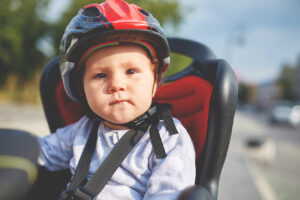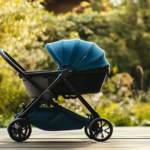
Jak bezpiecznie wozić dzieci na rowerze i co jest lepsze: fotelik czy przyczepka? „Opisywane są przypadki syndromu dziecka potrząsanego wywołanego zbyt długą jazdą”
Czy jako rodzice znamy zasady dotyczące bezpiecznego przewożenia dzieci rowerami? – Moje spostrzeżenia, nie tylko jako lekarza, ale również jako ojca, który aktywnie spędza czas ze swoimi dziećmi i dużo jeździ z nimi na rowerach, są takie, że większość osób prawidłowo zabezpiecza dzieci i dobrze je przewozi podczas jazdy rowerem – odpowiada dr Krzesimir Sieczych, specjalista ortopedii i traumatologii narządu ruchu w Carolina Medical Center (Grupa LUX MED).
Co jednak nie oznacza, że nie popełniamy błędów, które mogą negatywnie odbić się na zdrowiu dzieci, szczególnie na ich kształtującym się układzie kostnym.
Foteliki – zrób to mądrze
Najpopularniejszą formą przewożenia dzieci rowerami są foteliki. Producenci często podają zakres wiekowy, jednak najlepiej kierować się zakresem wagowym.
– Foteliki rowerowe powinno dopasowywać się do masy ciała dziecka – podkreśla dr Krzesimir Sieczych. Do wyboru mamy dwa rodzaje fotelików: przednie, montowane pomiędzy kierownicą a siodełkiem (dla młodszych dzieci) oraz tylne, mocowane do bagażnika albo rury podsiodłowej (dla starszych dzieci).
Foteliki montowane z przodu przeznaczone są dla dzieci do 15 kg, natomiast w fotelikach tylnych, w zależności od sposobu montowania, mogą jeździć dzieci nawet do 35 kg.
– Równie ważny jest dolny limit wieku oraz wagi, od kiedy dziecko można zacząć przewozić w foteliku. Na pewno dziecko musi mieć dobrze rozwinięty układ kostny i stabilnie trzymać głowę, na której, nie zapominajmy, w czasie podróży znajduje się kask. To dodatkowy ciężar, który podczas przejażdżki musi utrzymać na głowie małe dziecko. Kask podczas jazdy w foteliku jest obowiązkowy – podkreśla dr Krzesimir Sieczych i dodaje: – W przypadku mniejszych dzieci powinny to być krótkie przejażdżki. Nie wyobrażam sobie, żeby w foteliku rowerowym podróżowało kilkumiesięczne dziecko, np. półroczne. Te dzieci na taką podróż są za małe, mają za słabe mięśnie posturalne, nie utrzymają głowy, więc tego typu przejażdżki mogą spowodować przeciążenia na kręgosłupie.

Dr Krzesimir Sieczych / fot. archiwum prywatne
Ortopeda Carolina Medical Center poleca foteliki z opcją odchylenia oparcia do pozycji leżaka plażowego. Taka pozycja, zwłaszcza w przypadku młodszych dzieci, jest lepsza niż pozycja siedząca, kiedy plecy znajdują się w pionie.
– Foteliki bardzo często nie są amortyzowane, zwłaszcza te bez regulacji oparcia, co oznacza, że wożone w nich dzieci przyjmują na swój kręgosłup wszystkie obciążenia związane z nierównościami na drodze i wysokimi krawężnikami – wyjaśnia lekarz, zaznaczając, że dzieci przewożone w fotelikach rowerowych raczej nie powinny w nich zasypiać. Jeśli tak się stanie, możliwość przesunięcia oparcia do pozycji półleżącej będzie bardzo dobrym rozwiązaniem.
Co innego, jeśli dziecko cały czas znajduje się w pozycji siedzącej; wtedy głowa opada mu na jedną i/lub drugą stronę, a pozycja ciała staje się nienaturalna i obciążająca dla układu kostnego. – Można się ratować, na czas podróży podpierając głowę dziecka specjalną poduszką w kształcie podkowy. W literaturze fachowej opisywane są jednak przypadki syndromu dziecka potrząsanego wywołanego zbyt długą jazdą w foteliku rowerowym. To skutek zaśnięcia w foteliku – zwraca uwagę specjalista.
Bardzo dobrą opcją są też foteliki rowerowe z opcją regulacji podnóżków – takie foteliki „rosną” razem z dzieckiem.
Zakupy z głową
Inspekcja handlowa Urzędu Ochrony Konkurencji i Konsumentów systematycznie przeprowadza kontrole fotelików rowerowych. Przykładowo: w pierwszym kwartale 2021 roku pod lupę wzięto 10 województw. Kontrolerzy zakwestionowali 31 partii produktów, co stanowiło aż 33,7 proc. wszystkich sprawdzonych fotelików, z czego w 10 z nich stwierdzono wady stwarzające zagrożenie dla dzieci. Ujawniono nieprawidłowości takie jak m.in. odłączanie się małych elementów, brak skuteczności mocowania fotelika do roweru czy brak skuteczności systemu pasów zabezpieczających.
Dlatego eksperci UOKiK radzą, żeby przed kupnem fotelika sprawdzić, czy:
- nie ma ostrych, niebezpiecznych dla dziecka krawędzi i naroży,
- montowanie i demontaż wymagają zastosowania narzędzia lub uruchomienia dwóch zabezpieczeń równocześnie lub użycia dwóch niezależnych automatycznych systemów zamykających,
- kontakt stóp dziecka ze szprychami jest uniemożliwiony przez dodatkowe osłony z podnóżkami,
- podnóżki zaopatrzone są w paski ograniczające możliwość wysunięcia się stóp dziecka,
- foteliki tylne mają wyraźnie zaznaczony środek ciężkości,
- foteliki tylne mocowane do bagażnika mają dodatkowe złącze, nieodłączalne od fotelika, ograniczające jego ruch do tyłu.
O czym jeszcze trzeba pamiętać? Dr Krzesimir Sieczych radzi, aby upewnić się, czy fotelik posiada wymagane normy i/lub certyfikaty (norma EN 14344 lub certyfikat TUV/GS). Eksperci UOKiK zwracają uwagę, że w sprzedaży można dostać wiklinowe foteliki rowerowe. Prezentują się estetycznie i są niedrogie, ale z reguły nie spełniają żadnych standardów bezpieczeństwa i nie zapewniają dziecku odpowiedniego poziomu ochrony.
– Trzeba też sobie wyobrazić moment upadku – mówi ortopeda.
– Fotelik ma uchronić dziecko w momencie przewrócenia się roweru na bok, a gdy dziecko jest z tyłu, nie mamy żadnej możliwości osłonięcia go, dlatego ważne, aby dziecko podróżujące w foteliku było po bokach obudowane i zabezpieczone. Fotelik musi upadek zamortyzować.
I wreszcie pasy bezpieczeństwa: przypięcie nimi dziecka w czasie jazdy jest obowiązkowe.
Przepisy mówią, że „dziecko w wieku do 7 lat może być przewożone na rowerze przez osobę, która ukończyła 17 lat, pod warunkiem, że jest ono umieszczone na dodatkowym siodełku zapewniającym bezpieczną jazdę”.
Ortopeda: TAK dla przyczepek
Dr Krzesimir Sieczych jest natomiast wielkim zwolennikiem przyczepek (wózków) rowerowych. – Sam z nich korzystam, bo są one bezpieczniejsze niż foteliki i znacznie bardziej komfortowe dla dziecka. Posiadają duże, pompowane koła, amortyzację i, najczęściej, regulowane oparcie. Dziecko może w przyczepce jechać w pozycji półleżącej, a mniejsze w pozycji całkowicie leżącej. W takich przyczepkach montowane są adaptery dla niemowlaków, dzięki czemu maluch może podróżować jak w kołysce, co sprawia, że taka podróż w przyczepce może trwać długo. Maluch może spać i jest w pełni zabezpieczony – wyjaśnia lekarz.
Taka forma przewożenia dzieci według dra Sieczycha jest korzystna dla ich kręgosłupa oraz stawów.
Poza tym certyfikowane przyczepki wyposażone są m.in. w moskitierę, odblaski, folię przeciwdeszczową, hamulec, oświetlenie. Przy niektórych wózkach rowerowych znajduje się chorągiewka – nie jest ona obowiązkowym elementem wyposażenia, zwiększa jednak widoczność przyczepki, co – rzecz jasna – przekłada się na większe bezpieczeństwo podróżującego w niej dziecka.
Przepisy nie określają, czy dziecko wożone w przyczepce rowerowej musi mieć założony kask, choć eksperci to rekomendują. Konieczne jest natomiast przypięcie dziecka pasami bezpieczeństwa.
– W przyczepce rowerowej fajne jest też to – kontynuuje dr Krzesimir Sieczych – że może w niej jeździć dwójka dzieci. Maluchy nie nudzą się wtedy podczas jazdy.
Atutem przyczepek jest także elastyczne połączenie zabezpieczające przyczepkę przed wywróceniem, nawet w przypadku przewrócenia się roweru.
Minusy wózków rowerowych?
– Przyczepką należy jeździć po jezdni albo ścieżce rowerowej. Zgodnie z przepisami nie można jeździć po chodniku, chyba że jedzie z nami dziecko do 10. roku życia, również na rowerze. Pamiętajmy ponadto, że cały pojazd, czyli rower z przyczepką, nie może przekraczać 4 m długości – tłumaczy dr Sieczych i dodaje: – My często jeździmy całą rodziną na basen, przez miasto, i wtedy nasze najmłodsze dziecko, które ma 2,5 roku, podróżuje w przyczepce. Robimy jednak już pierwsze przymiarki do fotelika rowerowego.
Przepisy potwierdzają, że „jeżeli dziecko nie ukończyło 10. roku życia, może kierować rowerem na drodze publicznej wyłącznie pod opieką osoby dorosłej i jest traktowane jako pieszy (art. 2 pkt. 18 Ustawy Prawo o ruchu drogowym). Konsekwencją tego jest obowiązek poruszania się dziecka po chodniku (lub innej części drogi właściwej dla ruchu pieszych)”.
Uwaga! Przyczepka powinna być wyposażona w światło pozycyjne oraz światło odblaskowe (przynajmniej po jednym z tyłu).
Eksperci UOKiK radzą, żeby przy zakupie fotelika rowerowego – to samo tyczy się przyczepek – sprawdzić, czy:
- określono masę dziecka, dla którego dedykowany jest produkt,
- została dołączona instrukcja obsługi w języku polskim zawierająca zasady prawidłowego montażu, użytkowania i konserwacji,
- na produkcie, jego opakowaniu lub w instrukcji znajduje się nazwa i adres producenta – wiadomo wtedy, kto odpowiada za jakość i bezpieczeństwo produktu.
Zawsze przechowuj instrukcje i informacje dotyczące bezpiecznego użytkowania takich produktów, żeby móc w każdej chwili do nich zajrzeć.
Pytam jeszcze dra Sieczycha, co sądzi o biegaczach, którzy trenując, pchają przed sobą wózek (najczęściej trójkołowy) z dzieckiem. Czy to dla zdrowia i rozwoju takiego malucha jest bezpieczne? – Sam tak biegam – przyznaje doktor. – Choć akurat ja biegam z przyczepką, tylko zmieniam wtedy koła. Natomiast wózki do biegania mają koła większe niż wózki tradycyjne, posiadają też dobrą amortyzację, dzięki czemu, nawet jeśli biegamy po parku czy drodze szutrowej, to większa prędkość nie powoduje drgań ani niebezpiecznych wstrząsów.
Jeśli chcemy biegać z przyczepką, warto poszukać modelu, który w prosty sposób można przekształcić z wózka rowerowego w wózek biegowy (jogger).
Dr Krzesimir Sieczych – ortopeda traumatolog, na co dzień pracuje w Carolina Medical Center. Ortopeda Polskiej Reprezentacji Olimpijskiej na Igrzyskach w Tokio i Pekinie. Lekarz Kadry Narodowej w pływaniu. Prywatnie mąż i tata Heleny i Tadeusza, miłośnik sportu i aktywnego spędzania czasu.








































